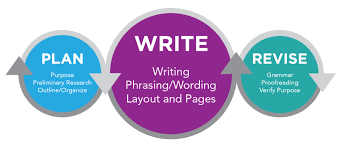
Over many years working with students as a writing tutor, I have developed an effective process for completing assignments and writing great essays:
1. Demystify the assignment
Students often have a hard time getting started with projects because they feel overwhelmed by the task itself. Many are not confident in their writing skills. They struggle to organize their thoughts. They have no idea how to proceed and this breeds procrastination.
My first step is to build rapport. I want them to understand that together we can do this. By breaking the process down into a series of simple steps, we can make it manageable. Once the students understand that I am here to help, that I believe they can succeed, and that I have a plan to help them do it, we can get past the foot-dragging and start moving toward our goal.
2. Master materials
If there is research material involved, it is of course essential to properly engage, digest, and master the relevant ideas. All too often students look for shortcuts, do not spend the proper amount of time and effort with class materials, and then wonder why they have so little to say when they begin to write.
This results in rambling, repetitive essays, stuffed with “filler” as students rush to meet the required page length in order to “get it over with.”
As a tutor, my job is to make sure that we do the necessary research in order to build a strong essay from the bottom up. In my experience, students will often come to appreciate that doing the proper leg work up front makes the actual writing much easier and faster. And of course with better results!
3. Brainstorm ideas
Once the student has properly mastered the materials, the next step is to brainstorm ideas, considering a range of possible themes and supporting points that might be raised in the paper.
Here, again, students often seek shortcuts, anxious to move forward with the first idea that comes to mind. Only later, when they are partially through the writing process, will they begin to discover any possible shortcomings with their initial idea.
When I work with students, I make sure we take the time to thoroughly consider a range of ideas, thinking things through ahead of time to make sure we set the stage for success by making the best possible choice.
3. Outline
Once we have our idea, the next step is to set-up an outline that identifies the major sections of the essay and pinpoints what we need to achieve in each. This makes the process more manageable for the student, giving them a road map they can follow to keep them moving through the process.
4. The first draft
Here I tell my students to shut down their critical voice and just write freely. Don’t worry if it’s not great…whatever the problems are, we can fix them later on. We just need a first draft that we can build from. Follow the road map and get to work!
5. Build Confidence
The truth is I am always seeking to build confidence at every stage of the process. Students are often fixated on their doubts, fears, and weaknesses. I constantly look to highlight their strengths and create small victories along the way. Not that we won’t improve on the weak spots, but in order to address those improvements the student first needs to feel some level of confidence and self-efficacy.
With this in mind, I will always begin my evaluation of student drafts by pointing out what I like about their work. With that established, we can then look at some of the areas where we can make the essay better.
6. Drill Down…get deep…and be more (or less) SPECIFIC
One common problem I see with early drafts (in addition to grammar mistakes etc.) is superficiality and/or a lack of detail. Students will sometimes skate over the surface and write very generally about the chosen topic. This prevents us from getting into the type of deep thoughts and feelings that make for the best essays.
Moreover, one of the keys to seeming authentic and believable to the reader is to provide very vivid and specific details. To this end I press my students to go deeper, think harder, and paint a picture of what we are trying to express.
[NOTE: In some cases students may have the opposite problem – they are telling their story with too much detail and getting lost in the weeds as a result. In either case, finding the right calibration between broad themes and precise detail is an important part of the process that I pay particular attention to. Getting this calibration right is a key to good academic writing.]
7. Re-Write
My next step is to give the student detailed notes and feedback on their initial draft, laying out exactly what needs to be done for the rewrite. In this manner we continue to work together, with the student submitting drafts, receiving feedback, and working through the rewrite process until we have the best possible essay.